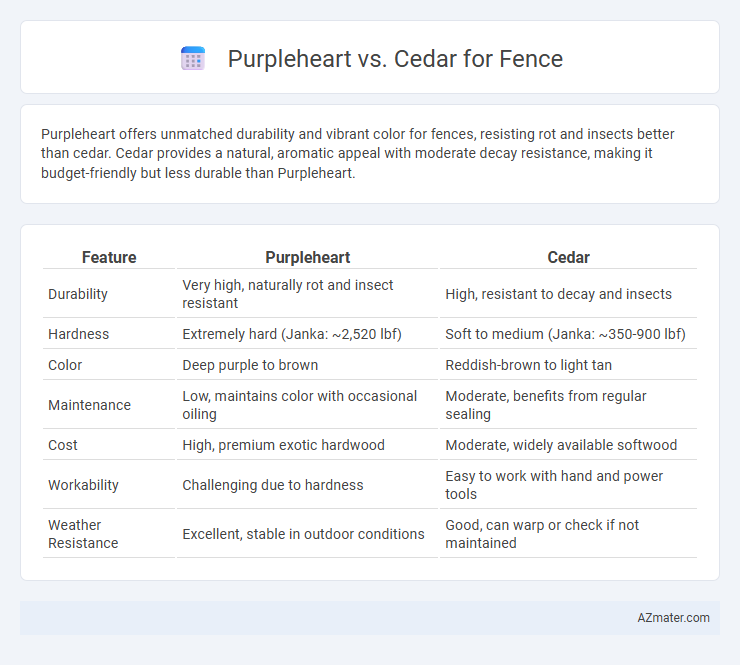Purpleheart offers unmatched durability and vibrant color for fences, resisting rot and insects better than cedar. Cedar provides a natural, aromatic appeal with moderate decay resistance, making it budget-friendly but less durable than Purpleheart.
Table of Comparison
| Feature | Purpleheart | Cedar |
|---|---|---|
| Durability | Very high, naturally rot and insect resistant | High, resistant to decay and insects |
| Hardness | Extremely hard (Janka: ~2,520 lbf) | Soft to medium (Janka: ~350-900 lbf) |
| Color | Deep purple to brown | Reddish-brown to light tan |
| Maintenance | Low, maintains color with occasional oiling | Moderate, benefits from regular sealing |
| Cost | High, premium exotic hardwood | Moderate, widely available softwood |
| Workability | Challenging due to hardness | Easy to work with hand and power tools |
| Weather Resistance | Excellent, stable in outdoor conditions | Good, can warp or check if not maintained |
Introduction to Purpleheart and Cedar Fencing
Purpleheart fencing offers exceptional durability and vibrant color retention, making it a premium choice for long-lasting outdoor structures. Cedar fencing is renowned for its natural resistance to decay and insect damage, with a classic warm tone that weathers gracefully over time. Both woods provide strong, aesthetically pleasing options for fence construction, with Purpleheart standing out for its superior hardness and Cedar favored for its aromatic qualities and ease of maintenance.
Wood Characteristics: Purpleheart vs Cedar
Purpleheart wood exhibits exceptional durability and rich purple hues that deepen with age, making it highly resistant to decay and insect damage, ideal for outdoor fencing. Cedar offers natural oils that provide resistance to moisture, rot, and insects, combined with a warm reddish tone and a lighter weight than Purpleheart. Both woods have distinct grain patterns, with Purpleheart's dense, coarse texture contrasting Cedar's smoother, more pliable surface, impacting maintenance and longevity.
Durability and Longevity Comparison
Purpleheart wood boasts exceptional durability with a Janka hardness rating of 2,520, making it highly resistant to dents, decay, and insect damage, ideal for long-lasting fencing. Cedar, particularly Western Red Cedar, features moderate durability with a Janka rating around 900 and natural oils that resist rot but typically requires more maintenance over time to preserve its integrity. Purpleheart fences can last several decades with minimal upkeep, whereas cedar fences generally have a lifespan of 15 to 20 years before significant repairs or replacement may be needed.
Resistance to Weather and Insects
Purpleheart wood exhibits exceptional resistance to weather elements and insect attacks due to its dense grain and natural oils, making it highly durable for fences in harsh climates. Cedar is naturally resistant to decay and insects because of its aromatic oils, but it is softer and may require more maintenance to withstand severe weather conditions. When comparing durability, Purpleheart offers superior longevity and protection against moisture and pests, ideal for long-term outdoor fence installations.
Maintenance Requirements for Each Wood
Purpleheart wood requires minimal maintenance due to its natural resistance to decay and insects, making it ideal for long-lasting fences. Cedar also offers good rot resistance but demands more regular upkeep, including annual sealing or staining to preserve its appearance and durability. Both woods benefit from occasional cleaning, but Purpleheart's dense grain reduces the frequency of maintenance compared to Cedar's more porous structure.
Appearance and Aesthetics
Purpleheart wood features rich, vibrant purples and deep hues that develop a striking, unique appearance over time, making it a bold choice for fences seeking standout aesthetics. Cedar offers warm reddish-brown tones and a naturally rustic, weathered look that ages gracefully with a silvery patina, ideal for traditional or natural outdoor settings. The choice between Purpleheart and Cedar for fences depends on whether a vivid, exotic appeal or a classic, earthy visual character is desired.
Environmental Impact and Sustainability
Purpleheart wood features high durability and natural resistance to decay, making it a long-lasting choice that reduces the frequency of replacements and lowers overall environmental impact. Cedar is known for its natural resistance to insects and rot, harvested from sustainably managed forests, which supports ecosystem balance and promotes responsible forestry practices. Both woods offer eco-friendly benefits, but Purpleheart's longevity can provide greater sustainability by minimizing resource consumption over time.
Cost Analysis: Purpleheart vs Cedar
Purpleheart hardwood typically costs between $15 to $20 per linear foot, reflecting its durability and exotic appeal, while cedar ranges from $10 to $15 per linear foot, offering a more budget-friendly option. Purpleheart's higher initial investment is offset by its exceptional resistance to rot and insect damage, reducing long-term maintenance costs compared to cedar, which may require more frequent treatments and repairs. Evaluating the total cost of ownership, purpleheart's longevity and structural integrity provide better value despite a steeper upfront price.
Installation Considerations
Purpleheart wood demands pre-drilling due to its extreme hardness, which can slow installation but ensures long-lasting strength and resistance to wear. Cedar offers easier handling and faster installment with fewer specialized tools needed, making it ideal for DIY projects or quick fence setups. Both woods require proper sealing to prevent moisture damage, but Purpleheart's natural density provides superior resistance to rot compared to cedar.
Choosing the Best Wood for Your Fence
Purpleheart offers exceptional durability and natural resistance to decay and insects, making it ideal for long-lasting fences in harsh weather conditions. Cedar is prized for its aromatic oils that repel pests and its natural resistance to moisture and rot, providing a beautiful and sustainable fencing option. When choosing the best wood for your fence, consider Purpleheart for unmatched strength and longevity, while cedar offers a balance of aesthetic appeal and environmental sustainability.

Infographic: Purpleheart vs Cedar for Fence
 azmater.com
azmater.com